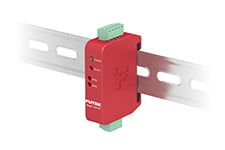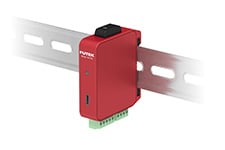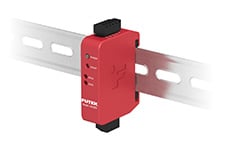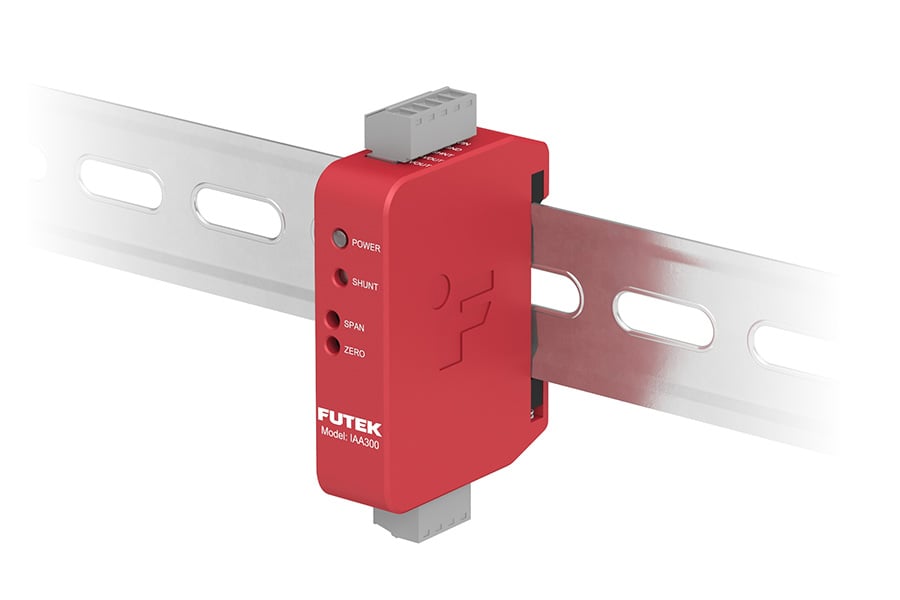Strain Gauge Analog Load Cell Amplifier
The IAA Series analog amplifiers convert millivolt signals into clean, reliable amplified outputs ready for DAQ, PLC, and control system integration. They are trusted by engineers worldwide to deliver best-in-class performance in a wide range of applications including aerospace, medical, automation and robotics, with the versatility, accuracy, and service support that make FUTEK a trusted partner for mission-critical systems.
| Spec / Model | IAA100 | IAA105 | IAA200 | IAA300 | Custom Solutions |
|---|---|---|---|---|---|
| Input Range (differential) | 0.5–10 mV/V | Up to ±10 mV/V | 0.5–10 mV/V | 0.5–10 mV/V | Explore Custom Electronics Solutions: Tailored amplifiers & sensor systems for unique performance, size, or environmental needs. |
| Output Type + Output Range | ±5 V or ±10 VDC | Up to ±10 VDC, including ±2.5 VDC or ±3.3 VDC | 4–20 mA Current | ±5 V or ±10 V Differential | |
| Accuracy (Non-linearity) | ±0.01% FSR | ±0.004% FSR | ±0.01% FSR | ±0.01% FSR | |
| Noise (p-p) | 10 mV | 2.8–6 mV | 15 µA | 2 mV | |
| Load Impedance | >14 kΩ | >2 kΩ | <500 Ω | >250 kΩ | |
| Bandwidth | 1k, 10k, 25 kHz | 1k, 10 kHz | 1k, 10k, 25 kHz | 100, 1k, 10k, 25k, 50 kHz | |
| Offset/Span Adjustment | Mechanical (screws) | Digital (via App) | Mechanical (screws) | Mechanical (screws) |
Universal Compatibility with Your Sensors
FUTEK IAA amplifiers provide unmatched versatility in system integration. Designed for full-bridge strain gauge sensors, they support a broad range of sensor types and outputs. Whether your application involves force measurement, torque sensing, pressure transducers, LVDTs, or multi-axis force/torque sensors, the IAA series ensures seamless compatibility and system-level flexibility. Configurable input ranges, multiple output options, and fast system tuning make it easy to adapt these amplifiers to your exact requirements.
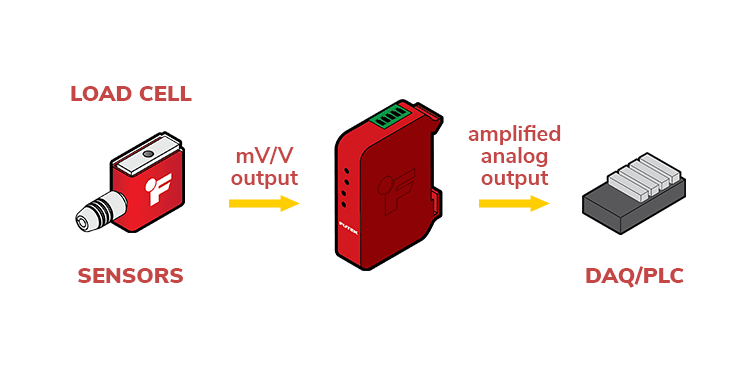
Sensor-Agnostic Compatibility
Supports full-bridge strain gauge-based sensors across force, torque, pressure, displacement, and multi-axis applications.
Multiple Output Options
Voltage (±5 V, ±10 V, ±2.5 V, ±3.3 V), Current ( 4–20, 0–20, 5–25, 12 ±8 mA), or Differential outputs match your system’s signal requirements.
Fast System Configuration
Selectable input ranges, DIP-switch or Bluetooth configuration, external shunt activation, and adjustable span/offset enable rapid tuning.
Industry-Leading Accuracy and Signal Integrity
When precision matters, the IAA Series delivers. With ultra-low noise, exceptional linearity, and configurable bandwidth, these amplifiers ensure the integrity of your measurement signals. Whether supporting aerospace test benches, medical devices, or advanced automation systems, IAA amplifiers provide the performance demanded by critical applications backed by rigorous validation and proven in the field.
Ultra-Low Noise Performance
Achieve exceptionally clean signals with noise as low as 2 mVp-p (IAA300), supporting high signal-to-noise ratio.
High Linearity and Accuracy
Nonlinearity up to ±0.004% FSR (IAA105), ensuring precise and repeatable measurements across the full scale.
Wide Selectable Bandwidth
Bandwidth options up to 50 kHz (IAA300) allow accurate capture of fast transients in demanding test environments.
Built to Last in Demanding Environments
IAA amplifiers are built to last and perform in the world’s toughest environments. From their rugged metallic enclosure (aluminum body and stainless steel cover) to their hot-swappable protection features and IPC Class III assembly standards, every unit is designed for long-term reliability. IAA amplifiers are extensively tested and validated to ensure performance in mission-critical applications across aerospace, medical, industrial, and R&D. Whether mounted in a control cabinet, test bench, or mobile system, FUTEK amplifiers deliver peace of mind and lifecycle value, just as FUTEK customers have come to expect.
Aerospace & Medical Grade Build
Designed and assembled to IPC Class III standards for mission-critical applications.
Rugged Industrial Construction
Precision-machined aluminum body with stainless steel cover provides exceptional mechanical strength and shielding. Rated to IP50 for protection against dust and contaminants.
Hot-Swappable with ESD & Onboard Protection
Onboard protection: Integrated ESD, over-voltage, and over-current protection for long-term durability. Supports hot swapping — critical for environments where system power cannot be interrupted.
Not Just an Amplifier: A Full-Service Experience
Choosing FUTEK IAA amplifiers means choosing a partner for your complete measurement solution. From initial model selection through system integration and long-term post-sales support, FUTEK provides unmatched engineering and calibration support. Our in-house calibration services ensure your entire measurement chain — sensor, cable, and amplifier — performs with documented accuracy and known system-level uncertainty.
Visit our Calibration Services page
Post-Sales Support
Our support does not end when you place the order. You can connect with FUTEK Tech Support for fast integration guidance and expert troubleshooting. No generic call centers — real experts who know your system.
System-Level Calibration Services
We calibrate your full measurement chain — sensor, cable, and amplifier — as a unified system. You receive traceable documentation of system-level measurement uncertainty.
High Performance Product. Proven Lifecycle Value.
IAA amplifiers are built to last and backed by premium service and long-term support. When precision, reliability, and peace of mind matter, FUTEK delivers — from initial install to years of operation.
